Sector Piezoelectric Sensor Array Transmitter Beamforming MUSIC Algorithm Based Structure Damage Imaging Method
Abstract
1. Introduction
2. SPATB-MUSIC Algorithm
2.1. Elastic Wave Signal Propagation Model under Sector Piezoelectric Array
2.2. Transmitter Beamforming under Dual Sector Piezoelectric Array
2.3. MUSIC Algorithm
- (1)
- The signal of the structural damage scattering array is obtained.
- (2)
- By using the transmitter beamforming equation, the damage scattering array signal is obtained.
- (3)
- The synthesized damage scattering array signal is decomposed by eigenvalue decomposition, and the orthogonal signal subspace and noise subspace are obtained.
- (4)
- The spatial spectrum of the corresponding monitoring region is obtained by spectral peak searching, and the corresponding coordinates of the spectral peak are the results of the damage location.
3. Propagation Characteristics of Elastic Waves in a Circular Bonded Structure
3.1. Circular Bonded Structure and Experimental Setup
3.2. Propagation Characteristics of Elastic Waves in Circular Bonded Structures
4. Damage Location in Circular Bonded Structures
4.1. Damage in the Structure and Monitoring
4.2. Effect of Damage on the Signal
4.3. Transmitter Beamforming of Damage Scattering Array Signal
4.4. Damage Localization Result
5. Conclusions
Author Contributions
Funding
Conflicts of Interest
References
- Ihn, J.B.; Chang, F.K. Pitch-catch active sensing methods in structural health monitoring for aircraft structures. Struct. Health Monit. 2008, 7, 5–19. [Google Scholar] [CrossRef]
- Brownjohn, J. Structural health monitoring of civil infrastructure. Philos. Trans. Math. Phys. Eng. Sci. 2007, 365, 589–622. [Google Scholar] [CrossRef] [PubMed]
- Diamanti, K.; Soutis, C. Structural health monitoring techniques for aircraft composite structures. Prog. Aerosp. Sci. 2010, 46, 342–352. [Google Scholar] [CrossRef]
- Qiu, L.; Yuan, S.; Mei, H.; Fang, F. An improved Gaussian mixture model for damage propagation monitoring of an aircraft wing spar under changing structural boundary conditions. Sensors 2016, 16, 291. [Google Scholar] [CrossRef] [PubMed]
- Yuan, S.; Lai, X.; Zhao, X.; Xu, X.; Zhang, L. Distributed structural health monitoring system based on smart wireless sensor and multi-agent technology. Smart Mater. Struct. 2006, 15, 1–8. [Google Scholar] [CrossRef]
- Wu, J.; Yuan, S.; Ji, S.; Zhou, G.; Wang, Y.; Wang, Z. Multi-agent system design and evaluation for collaborative wireless sensor network in large structure health monitoring. Expert Syst. Appl. 2010, 37, 2028–2036. [Google Scholar] [CrossRef]
- Giurgiutiu, V.; Zagrai, A.; Bao, J.J. Piezoelectric wafer embedded active sensors for aging aircraft structural health monitoring. Struct. Health Monit. 2002, 1, 41–61. [Google Scholar] [CrossRef]
- Su, Z.; Ye, L.; Lu, Y. Guided Lamb waves for identification of damage in composite structures: A review. J. Sound Vib. 2006, 295, 753–780. [Google Scholar] [CrossRef]
- Qiu, L.; Yuan, S.; Zhang, X.; Wang, Y. A time reversal focusing based impact imaging method and its evaluation on complex composite structures. Smart Mater. Struct. 2011, 20, 105014. [Google Scholar] [CrossRef]
- Raghavan, A. Guided-wave structural health monitoring. Diss. Abstr. Int. 2007, 975, 91–114. [Google Scholar] [CrossRef]
- Chen, J.; Yuan, S.; Jin, X. On-line prognosis of fatigue cracking via a regularized particle filter and guided wave monitoring. Mech. Syst. Signal. Process. 2019, 131, 1–17. [Google Scholar] [CrossRef]
- Chen, X.; Michaels, J.E.; Michaels, T.E. A methodology for estimating guided wave scattering patterns from sparse transducer array measurements. IEEE Trans. Ultrason. Ferroelectr. Freq. Control 2015, 62, 208–2019. [Google Scholar] [CrossRef] [PubMed]
- Yuan, S.; Ren, Y.; Qiu, L.; Mei, H. A multi-response-based wireless impact monitoring network for aircraft composite structures. IEEE Trans. Ind. Electron. 2016, 63, 7712–7722. [Google Scholar] [CrossRef]
- Qing, X.; Li, W.; Wang, Y.; Sun, H. Piezoelectric transducer-based structural health monitoring for aircraft applications. Sensors 2019, 19, 545. [Google Scholar] [CrossRef]
- Croxford, A.J.; Wilcox, P.D.; Drinkwater, B.W.; Konstantinidis, G. Strategies for guided-wave structural health monitoring. Proc. R. Soc. A Math. Phys. Eng. Sci. 2007, 463, 2961–2981. [Google Scholar] [CrossRef]
- Mei, H.; Mohammad, F.H.; Joseph, R.; Migot, A.; Giurgiutiu, V. Recent advances in piezoelectric wafer active sensors for structural health monitoring applications. Sensors 2019, 19, 383. [Google Scholar] [CrossRef]
- Michaels, J.E.; Michaels, T.E. Guided wave signal processing and image fusion for in situ damage localization in plates. Wave Motion. 2007, 44, 482–492. [Google Scholar] [CrossRef]
- Ren, Y.; Qiu, L.; Yuan, S.; Fang, F. Gaussian mixture model and delay-and-sum based 4D imaging of damage in aircraft composite structures under time-varying conditions. Mech. Syst. Signal. Process. 2020, 135, 106390. [Google Scholar] [CrossRef]
- Qing, X.; Beard, S.; Shen, S.B.; Banerjee, S.; Bradley, I.; Salama, M.M.; Chang, F.K. Development of a real-time active pipeline integrity detection system. Smart Mater. Struct. 2009, 18, 115010. [Google Scholar] [CrossRef]
- Su, Z.; Cheng, L.; Wang, X.M.; Yu, L.; Zhou, C. Predicting delamination of composite laminates using an imaging approach. Smart Mater. Struct. 2009, 18, 74002. [Google Scholar] [CrossRef]
- Wang, Q.; Yuan, S. Baseline-free imaging method based on new PZT sensor arrangements. J. Intell. Mater. Syst. Struct. 2009, 20, 1663–1673. [Google Scholar]
- Cai, J.; Shi, L.; Yuan, S.; Shao, Z. High spatial resolution imaging for structural health monitoring based on virtual time reversal. Smart Mater. Struct. 2011, 20, 055018. [Google Scholar] [CrossRef]
- Wang, J.; Shen, Y. An enhanced Lamb wave virtual time reversal technique for damage detection with transducer transfer function compensation. Smart Mater. Struct. 2019, 28, 085017. [Google Scholar] [CrossRef]
- Rao, J.; Ratassepp, M.; Lisevych, D.; Caffoor, M.H.; Fan, Z. On-line corrosion monitoring of plate structures based on guided wave tomography using piezoelectric sensors. Sensors 2017, 17, 2882. [Google Scholar] [CrossRef] [PubMed]
- Wang, S.; Wu, W.; Shen, Y.; Liu, Y.; Jiang, S. Influence of the PZT sensor array configuration on Lamb wave tomography imaging with the RAPID algorithm for hole and crack detection. Sensors 2020, 20, 860. [Google Scholar] [CrossRef]
- Wilcox, P. Omni-directional guided wave transducer arrays for the rapid inspection of large areas of plate structures. IEEE Trans. Ultrason. Ferroelectr. Freq. Control 2003, 50, 699–709. [Google Scholar] [CrossRef]
- Malinowski, P.; Wandowski, T.; Trendafilova, I.; Ostachowicz, W. A phased array-based method for damage detection and localization in thin plates. Struct. Health Monit. 2009, 8, 5–15. [Google Scholar] [CrossRef]
- Yoo, B.; Purekar, A.S.; Zhang, Y.; Pines, D.J. Piezoelectric-paint-based two-dimensional phased sensor arrays for structural health monitoring of thin panels. Smart Mater. Struct. 2010, 19, 075017. [Google Scholar] [CrossRef]
- Bencheikh, M.L.; Wang, Y. Joint DOD-DOA estimation using combined ESPRIT-MUSIC approach in MIMO radar. Electron. Lett. 2010, 46, 1081–1083. [Google Scholar] [CrossRef]
- Santosh, S.; Sharma, K. A review on multiple emitter location and signal parameter estimation. IEEE Trans. Antennas Propag. 2003, 34, 276–280. [Google Scholar]
- Engholm, M.; Stepinski, T. Direction of arrival estimation of Lamb waves using circular arrays. Struct. Health Monit. 2011, 9, 467–480. [Google Scholar] [CrossRef]
- Yang, H.J.; Lee, Y.J.; Lee, S.K. Impact source localization in plate utilizing multiple signal classification. Proc. Inst. Mech. Eng. Part C J. Mech. Eng. Sci. 2013, 227, 703–713. [Google Scholar] [CrossRef]
- Yang, H.; Shin, T.J.; Lee, S. Source location in plates based on the multiple sensors array method and wavelet analysis. J. Mech. Sci. Technol. 2014, 28, 1–8. [Google Scholar] [CrossRef]
- Yuan, S.; Zhong, Y.; Qiu, L.; Wang, Z. Two-dimensional near-field multiple signalclassification algorithm-based impact localization. J. Intell. Mat. Syst. Struct. 2015, 26, 400. [Google Scholar] [CrossRef]
- Yuan, S.; Bao, Q.; Qiu, L.; Zhong, Y. A single frequency component-based re-estimated MUSIC algorithm for impact localization on complex composite structures. Smart Mater. Struct. 2015, 24, 105021. [Google Scholar] [CrossRef]
- Zhong, Y.; Yuan, S.; Qiu, L. Multiple damage detection on aircraft composite structures using near-field MUSIC algorithm. Sens. Actuat. A Phys. 2014, 214, 234–244. [Google Scholar] [CrossRef]
- Golato, A.; Ahmad, F.; Santhanam, S.; Amin, M.G. Multi-helical path exploitation in sparsity-based guided-Wave imaging of defects in pipes. J. Nondestruct. Eval. 2018, 37, 27. [Google Scholar] [CrossRef]
- Li, G.; Chattopadhyay, A. Reference-free damage localization in time-space domain for structural health monitoring of X-COR sandwich composites. J. Intell. Mater. Syst. Struct. 2019, 30, 371–385. [Google Scholar] [CrossRef]
- Xiao, H.; Shen, Y.; Xiao, L.; Qu, W.; Lu, Y. Damage detection in composite structures with high-damping materials using time reversal method. Nondestruct. Test. Eval. 2018, 33, 329–345. [Google Scholar] [CrossRef]
- Song, F.; Huang, G.L.; Hu, G.K. Online guided wave-based detection in honeycomb sandwich structures. Aiaa J. 2012, 50, 284–293. [Google Scholar] [CrossRef]
- Bao, Q.; Yuan, S.; Guo, F.; Qiu, L. Transmitter beamforming and weighted image fusion–based multiple signal classification algorithm for corrosion monitoring. Struct. Health Monit. 2019, 18, 621–634. [Google Scholar] [CrossRef]
- Bao, Q.; Yuan, S.; Wang, Y.; Qiu, L. Anisotropy compensated MUSIC algorithm based composite structure damage imaging method. Compos. Struct. 2019, 214, 293–303. [Google Scholar] [CrossRef]
- Qiu, L.; Yuan, S. On development of a multi-channel PZT array scanning system and its evaluating application on UAV wing box. Sens. Actuators A Phys. 2009, 151, 220–230. [Google Scholar] [CrossRef]
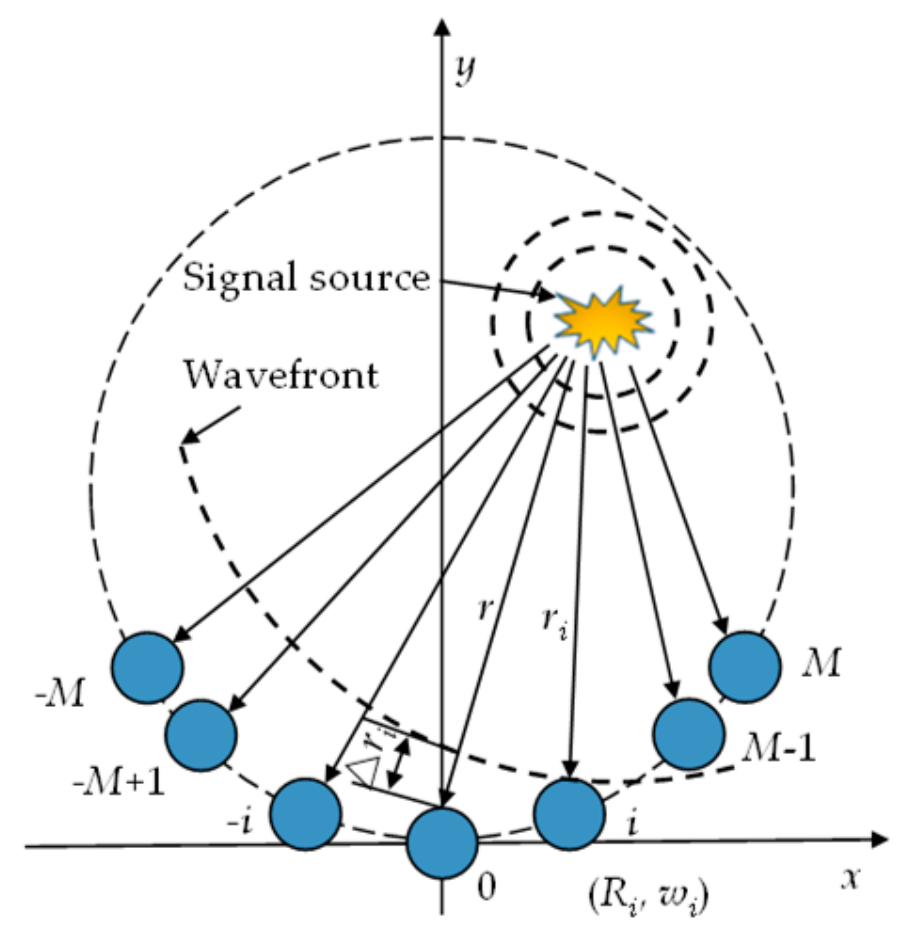
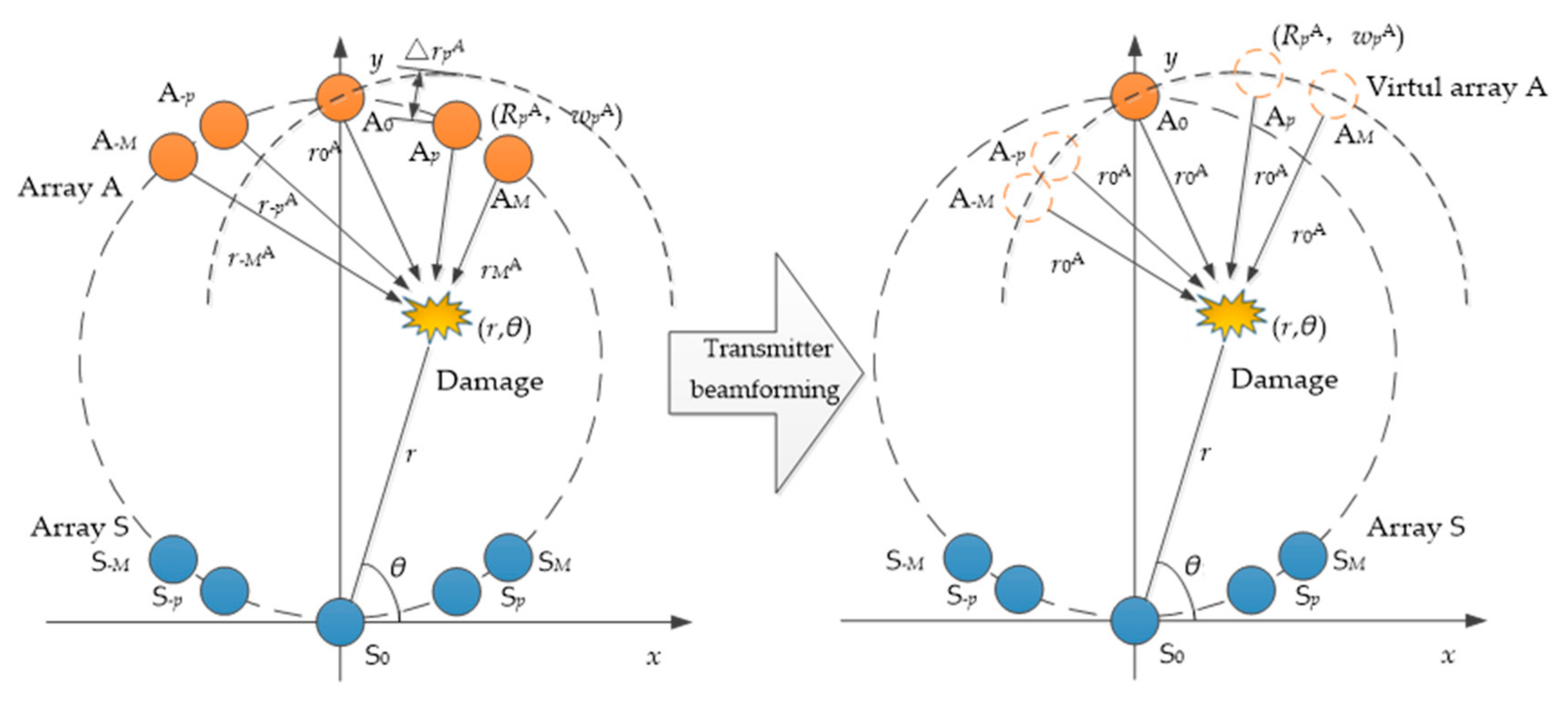
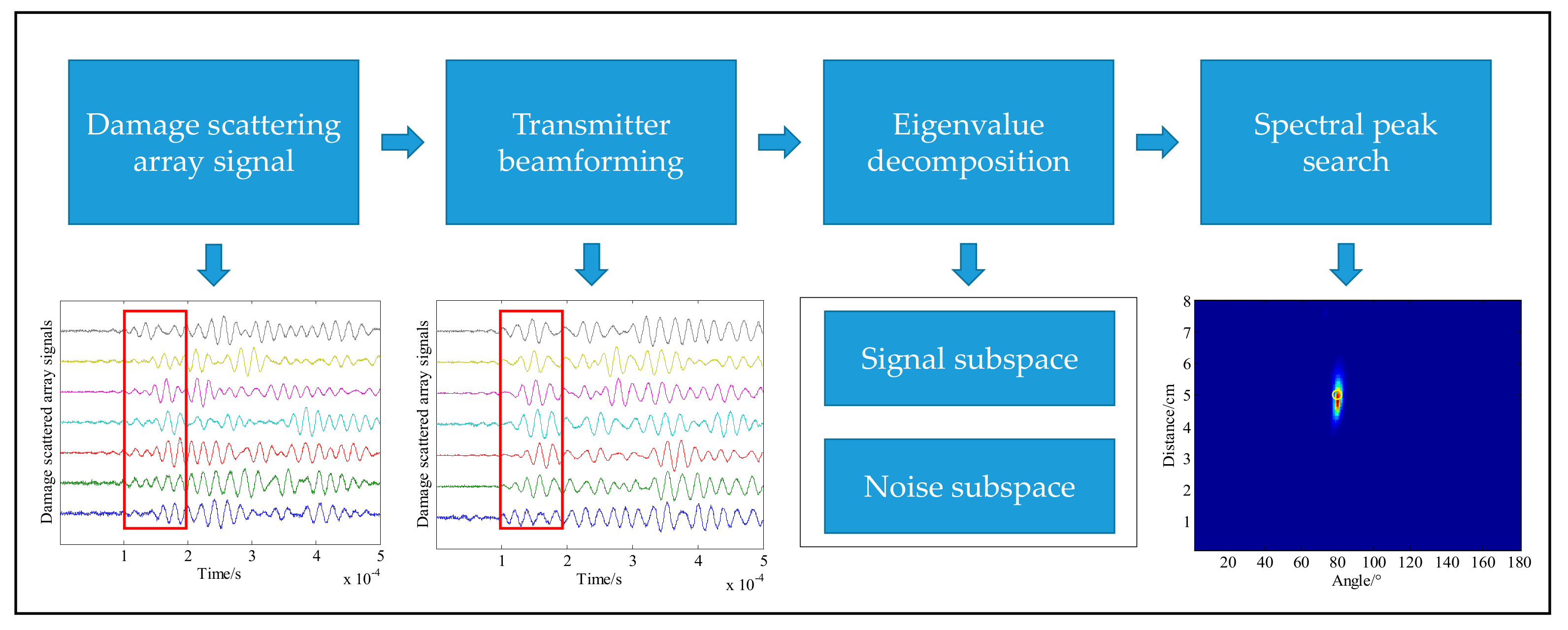

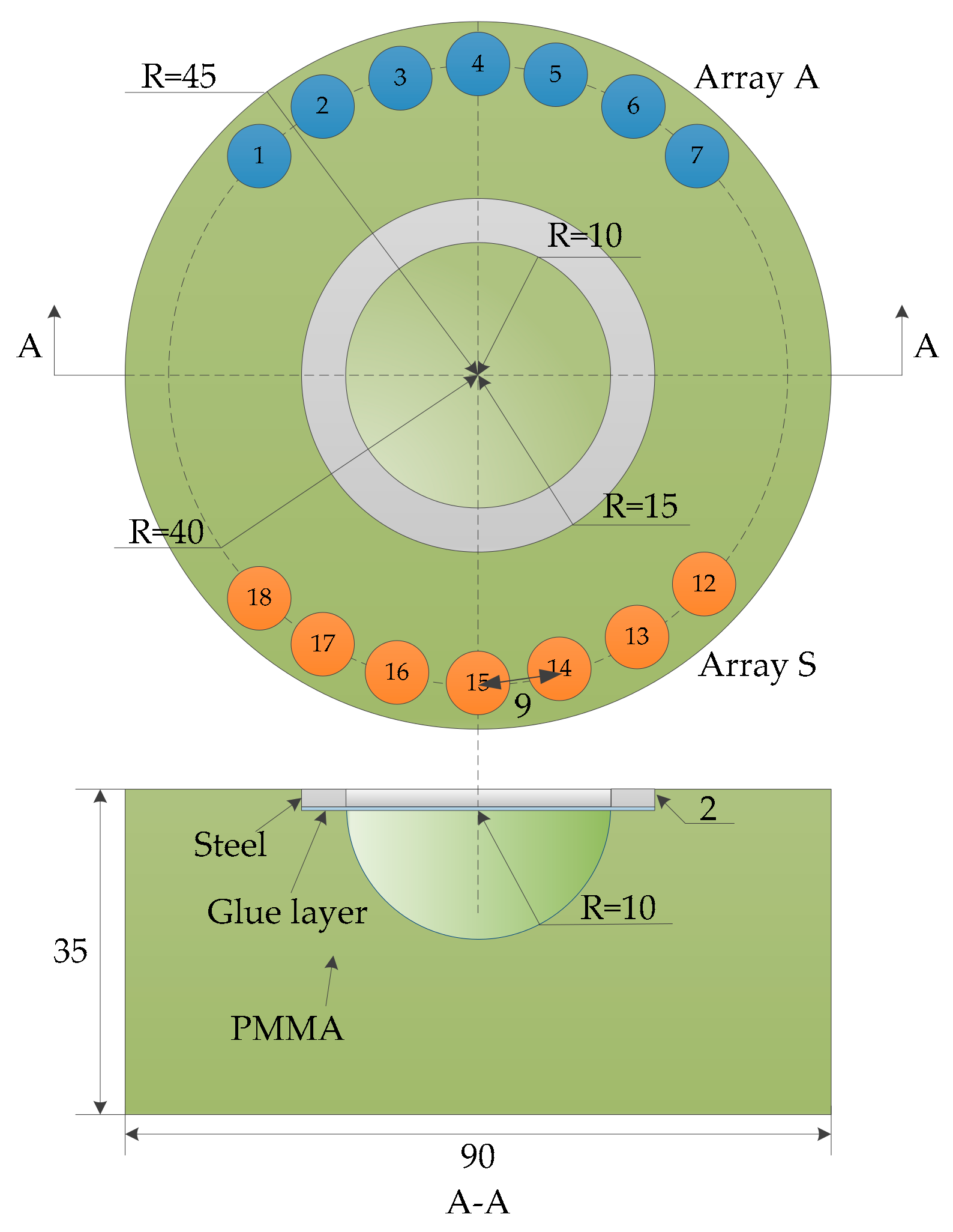
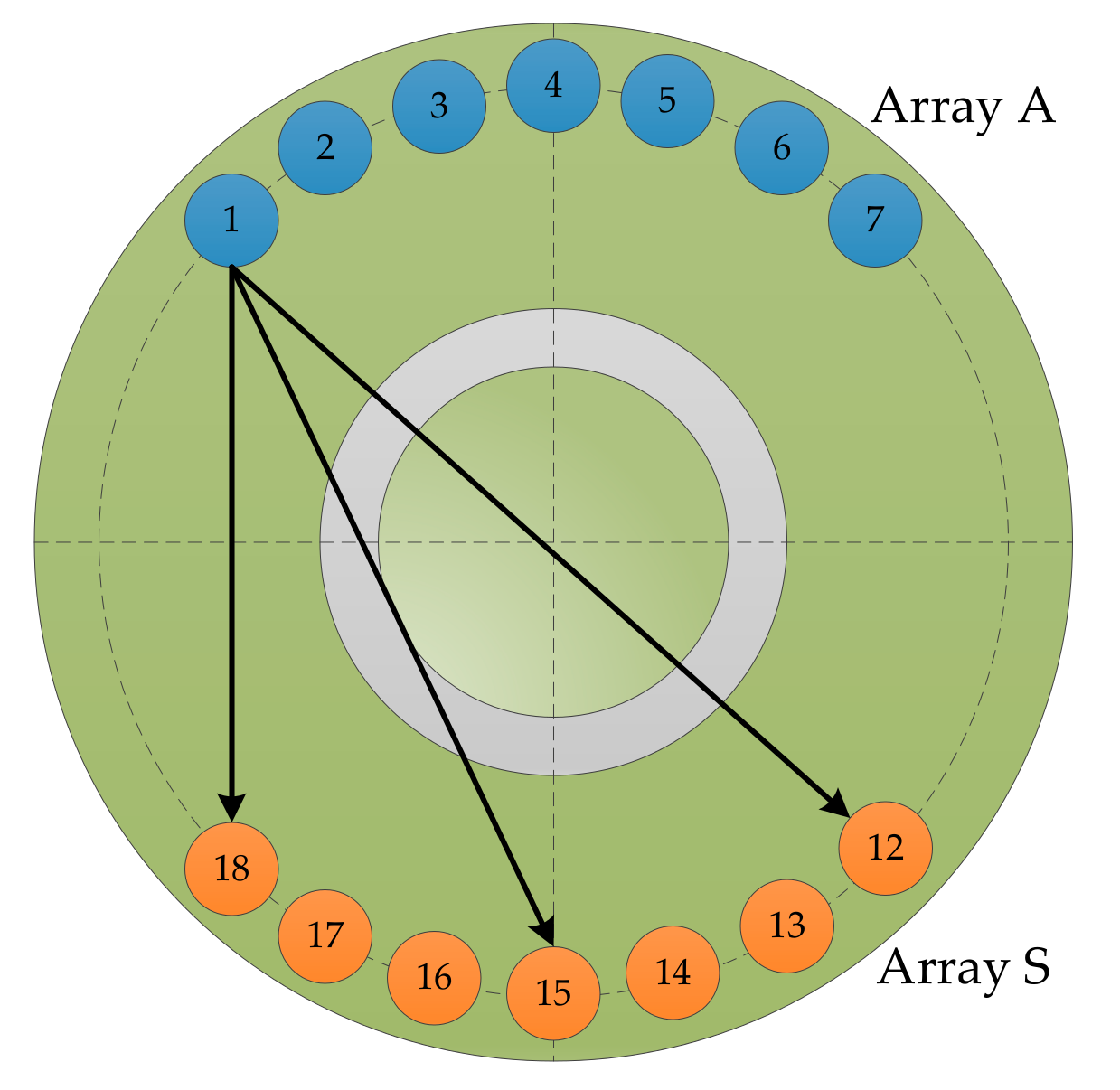
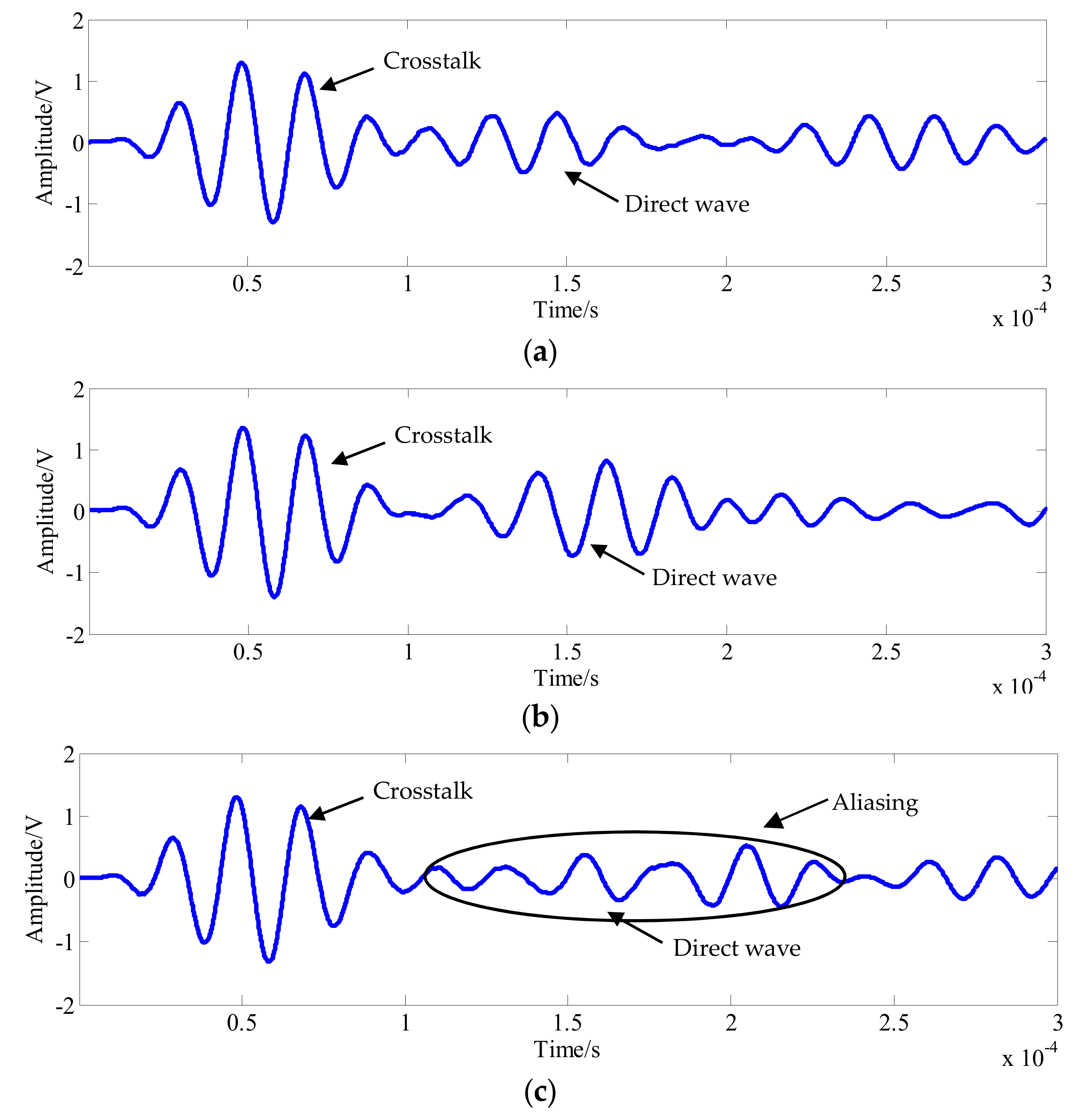
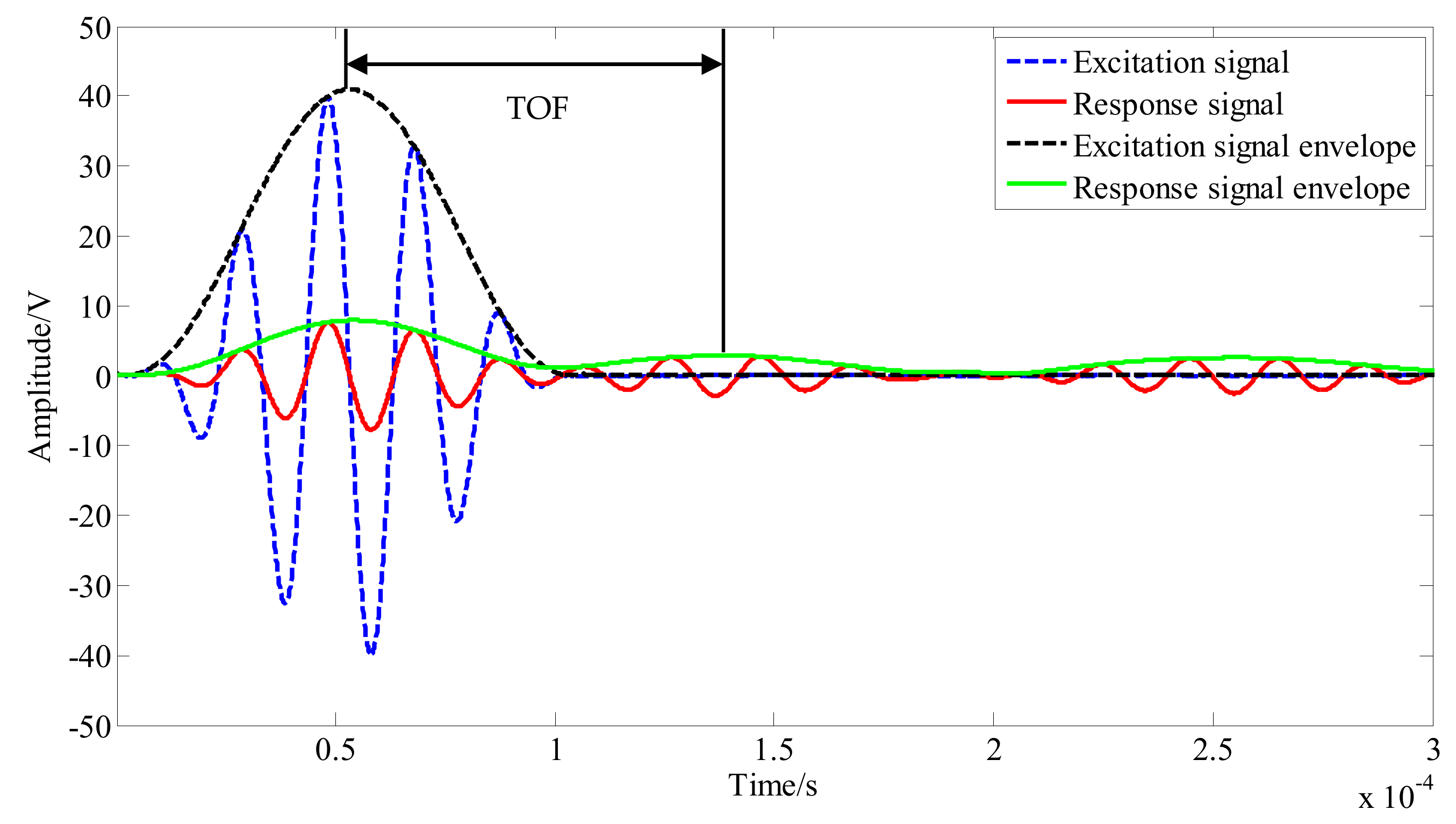

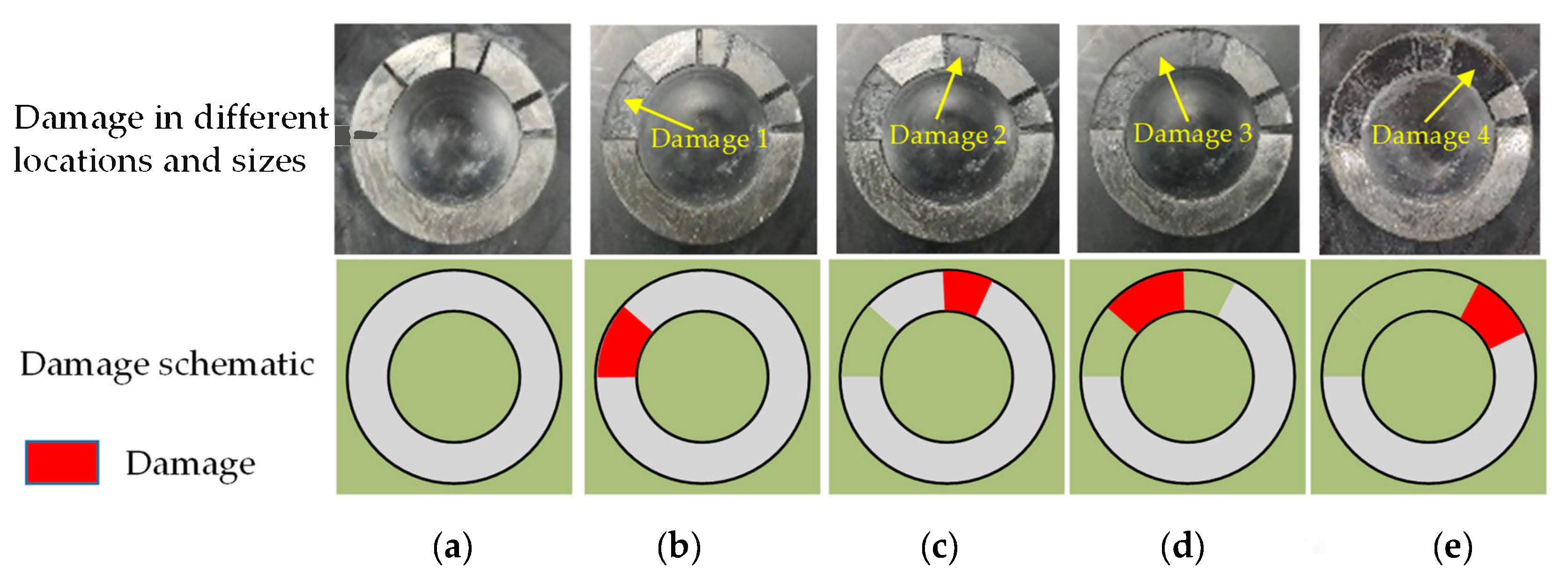
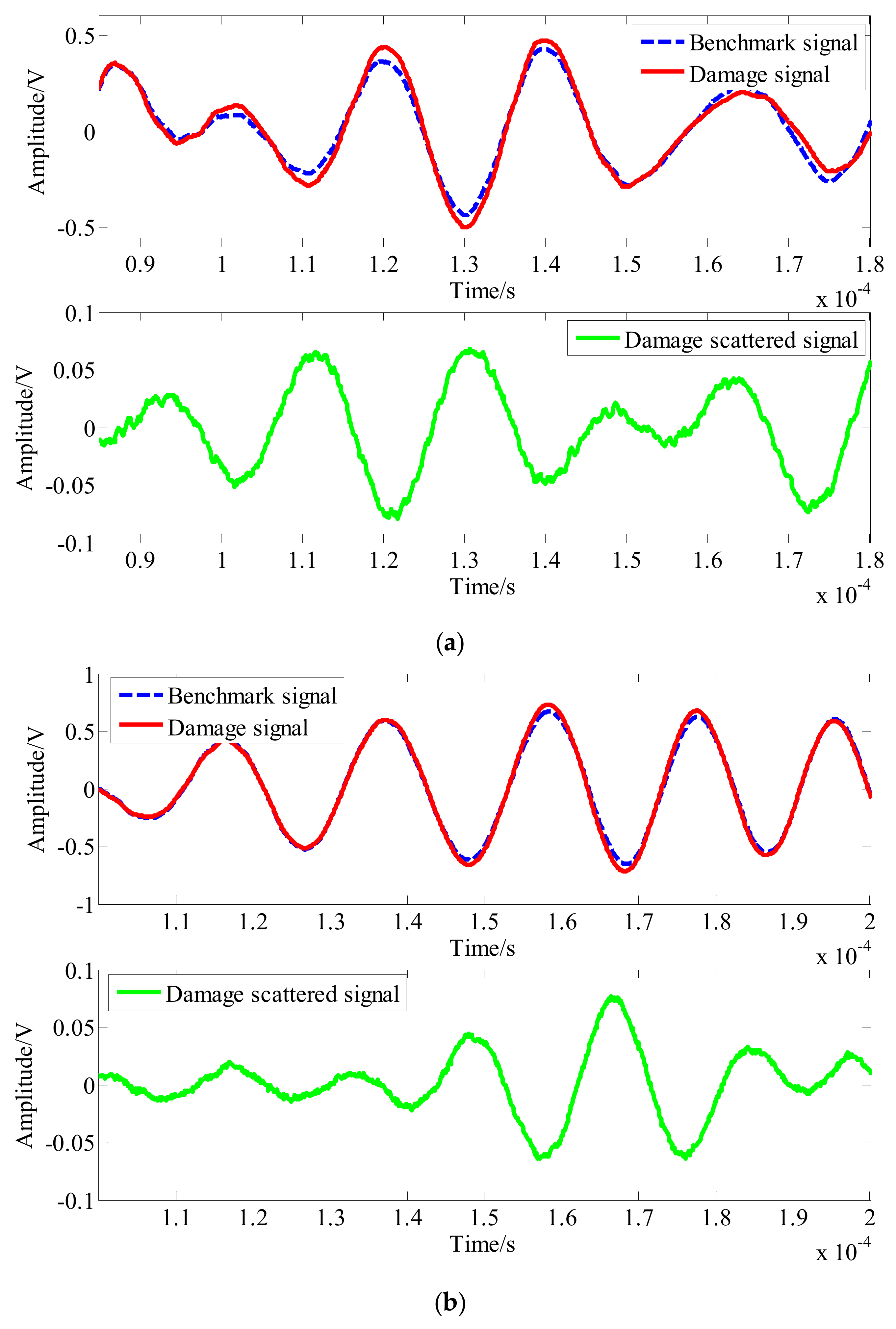
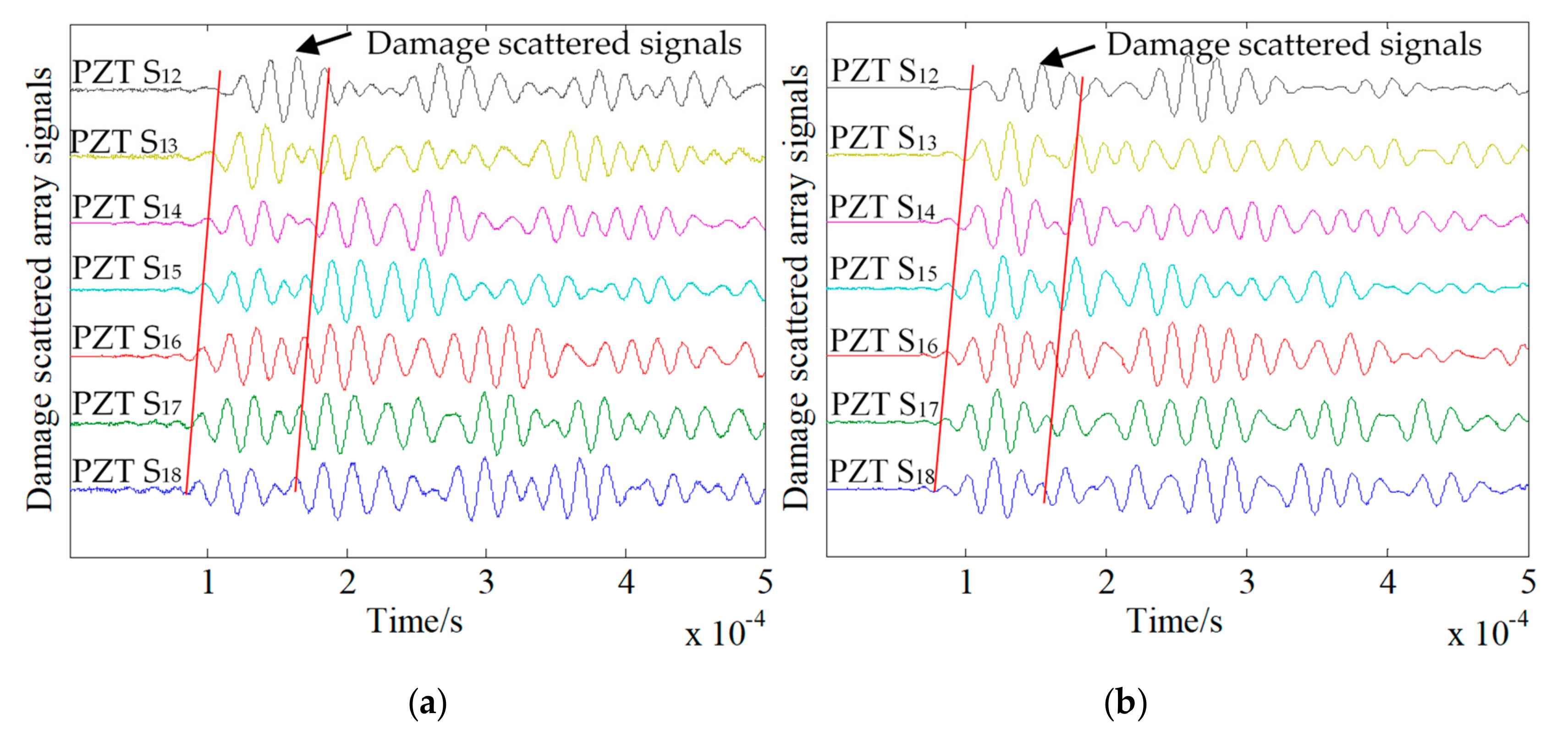
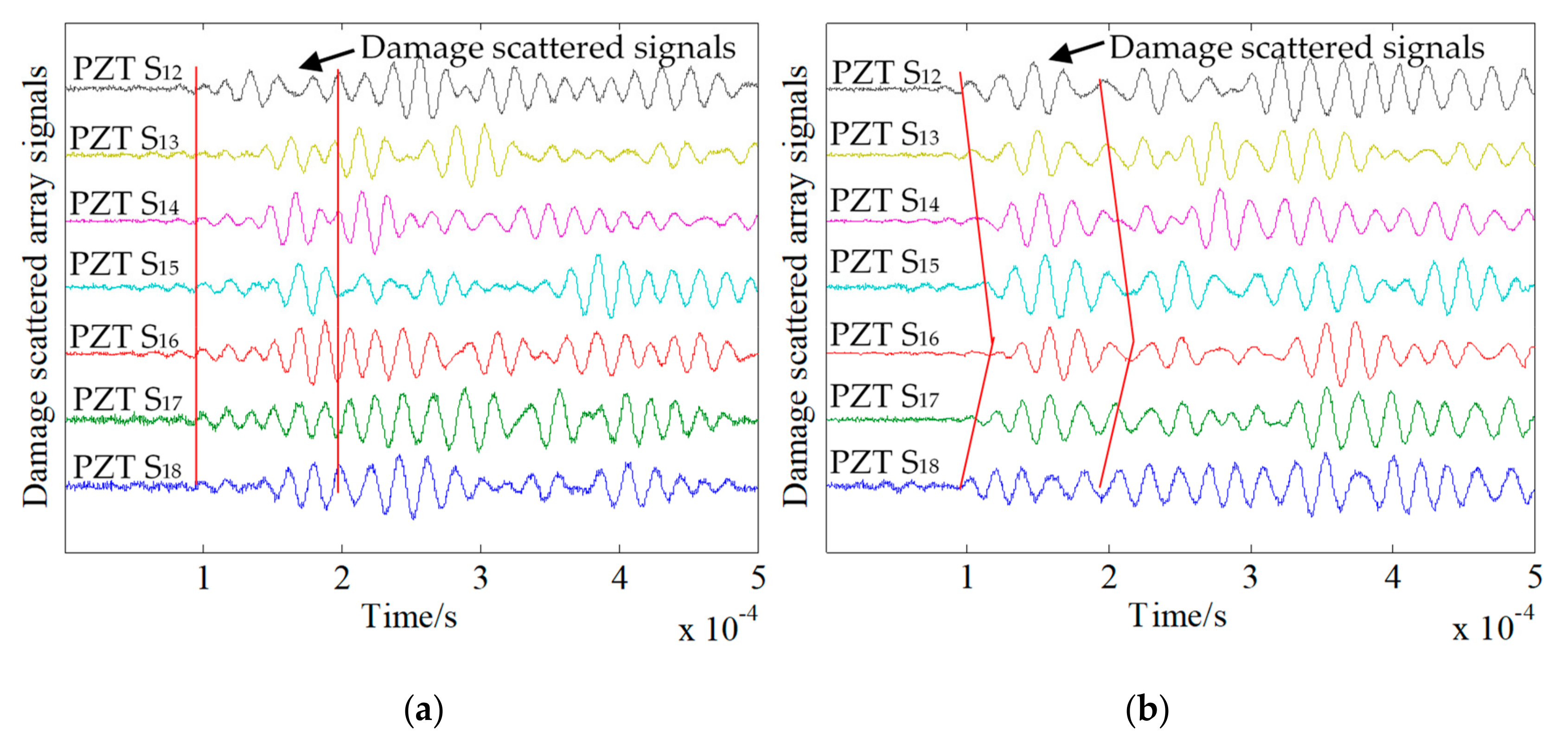
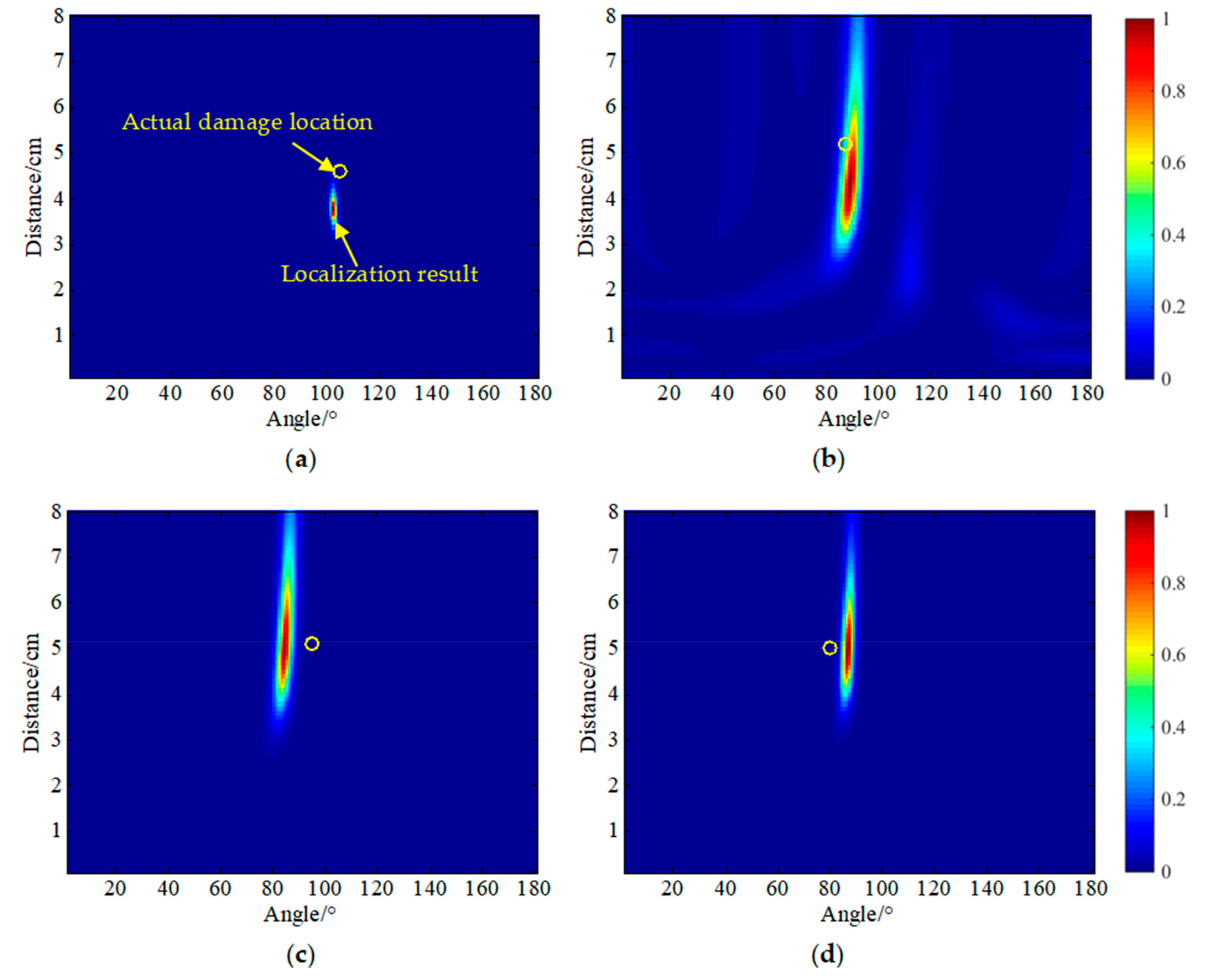
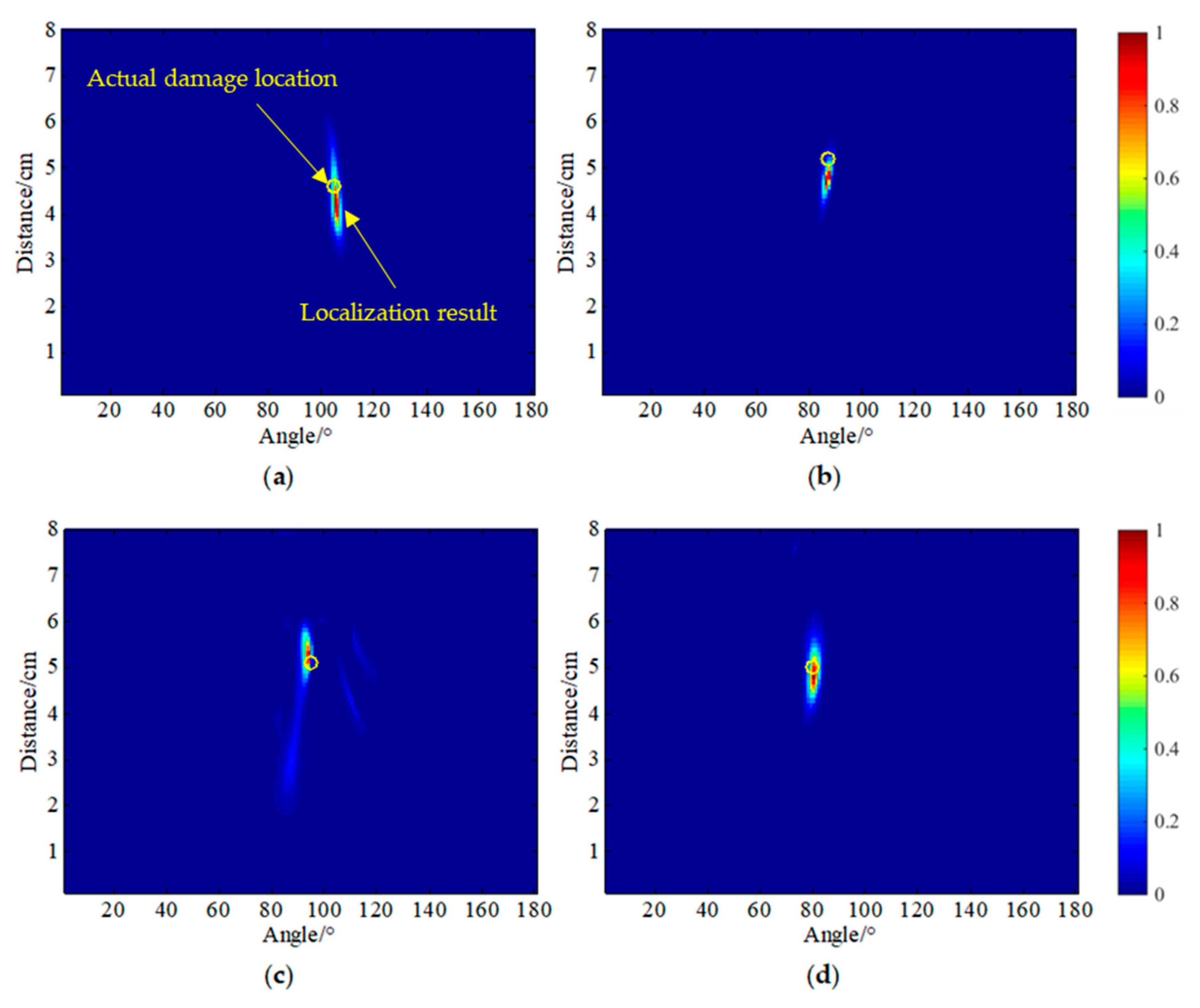

| Propagation Paths | Amplitude | Velocity |
|---|---|---|
| PZT A1-PZT S18 | 0.486 V | 722 m/s |
| PZT A1-PZT S15 | 0.814 V | 699 m/s |
| PZT A1-PZT S12 | 0.383 V | 755 m/s |
| Number | Size | Locations |
|---|---|---|
| D1 | 10 × 5 mm2 | (105°, 4.6 cm) |
| D2 | 5 × 5 mm2 | (87°, 5.2 cm) |
| D3 | 10 × 5 mm2 | (95°, 5.1 cm) |
| D4 | 10 × 5 mm2 | (80°, 5.0 cm) |
| Number | Locations | Single Transmitter MUSIC | SPATB-MUSIC | ||||
|---|---|---|---|---|---|---|---|
| Localization Results | Error | Localization Results | Error | ||||
| Angle | Distance | Angle | Distance | ||||
| D1 | (105°, 4.6 cm) | (103°, 3.8 cm) | 3° | 0.8 cm | (105°, 4.3 cm) | 0° | 0.3 cm |
| D2 | (87°, 5.2 cm) | (88°, 4.2 cm) | 1° | 1.0 cm | (86°, 4.7 cm) | 1° | 0.5 cm |
| D3 | (95°, 5.1 cm) | (84°, 5.0 cm) | 11° | 0.1 cm | (94°, 5.3 cm) | 1° | 0.2 cm |
| D4 | (80°, 5.0 cm) | (86°, 4.9 cm) | 6° | 0.1 cm | (80°, 4.8 cm) | 0° | 0.2 cm |
| Imaging Methods | Path Imaging | Delay-Sum Imaging | SPATB-MUSIC |
|---|---|---|---|
| Errord | 1.5 cm | 1.1 cm | 0.5 cm |
| Errorσ | 18.8% | 13.8% | 6.3% |
© 2020 by the authors. Licensee MDPI, Basel, Switzerland. This article is an open access article distributed under the terms and conditions of the Creative Commons Attribution (CC BY) license (http://creativecommons.org/licenses/by/4.0/).
Share and Cite
Fu, T.; Wang, Y.; Qiu, L.; Tian, X. Sector Piezoelectric Sensor Array Transmitter Beamforming MUSIC Algorithm Based Structure Damage Imaging Method. Sensors 2020, 20, 1265. https://doi.org/10.3390/s20051265
Fu T, Wang Y, Qiu L, Tian X. Sector Piezoelectric Sensor Array Transmitter Beamforming MUSIC Algorithm Based Structure Damage Imaging Method. Sensors. 2020; 20(5):1265. https://doi.org/10.3390/s20051265
Chicago/Turabian StyleFu, Tao, Yi Wang, Lei Qiu, and Xin Tian. 2020. "Sector Piezoelectric Sensor Array Transmitter Beamforming MUSIC Algorithm Based Structure Damage Imaging Method" Sensors 20, no. 5: 1265. https://doi.org/10.3390/s20051265
APA StyleFu, T., Wang, Y., Qiu, L., & Tian, X. (2020). Sector Piezoelectric Sensor Array Transmitter Beamforming MUSIC Algorithm Based Structure Damage Imaging Method. Sensors, 20(5), 1265. https://doi.org/10.3390/s20051265




